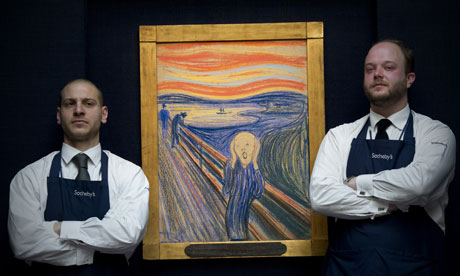The Scream: a global cliche with a £50m price tag

Sotheby's employees in London pose with the only original of The Scream that can be seen outside Oslo. Photograph: Carl Court/AFP/Getty Images
A woman of maybe 75 enters the lobby of Sotheby’s and says, with some flourish, “I want to see the Scream. Munch’s The Scream!” She looks as though she’s expecting someone to stop her. But there is just a flight of stairs and 26 security guards between her and this work of art. Nothing will stop her.
There are four copies, two painting and two pastels, and that is not counting the trillions of posters on students’ walls, yawning back decades, touching every adolescence in living memory and beyond, which has ever been touched by the thought, “see that picture? That’s me, that is”.
One painting and one pastel are in the Munch museum in Oslo, and one painting is in Norway’s National Gallery, in the same city.
Having had two of them stolen, blessedly recovered, in 1994 and 2004, Norway will never lend them. They’d never get the insurance. But there is also this fourth version, painted third chronologically, which will be sold in New York on 2 May. It is on show in New Bond Street now. This might be the last time in your life that you could see it (unless you go to Norway).
“I’ve been coming here for donkey’s years,” said a woman who wished to remain anonymous, “and I’ve never been through two security gates. I mean, that Matisse is worth £30m – the reserve price is below it, as you know – and there’s no security round that.” She leans in: “I think there’s an element of marketing. Which is a little bit silly, because we all know who’s going to buy it anyway.” (I can’t tell you who – partly because Sotheby’s say this is nonsense, it will go to auction in a proper way. And partly because I don’t know.)
Approaching the work has the kind of ceremony you’d imagine they’d put on for the pope, or a dictator. You go through the security, the queue control, past the Miró, and there you are, in a totally dark room, this iconic creation glowing from the darkness as if possessed by a mystical force.
Morrissey’s voice blasts into my head with “I know the wind-swept mystical air/ it means I’d like to see your underwear”. I’m being flooded with teenage cultural reference, that’s what’s going on here.
Simon Shaw, Sotheby’s head of impressionist and modern art, remarks, “It’s so well known, so familiar; everybody’s seen the pastiches, the parodies, the toys, the cartoons. You might think it would lose its power, but it doesn’t. When you look at the Mona Lisa, it looks exactly as you’d expect it to look. This is quite different.”
Martha Freud emerged from the darkened room. “I was just trying to think what the artist was thinking when he did it, and that terrified me.” She paused. “Whenever I see paintings with which I’m very familiar, I’m always surprised at how small they are.” Which is funny, because that’s what I was thinking about her.
Masterpieces as important as this one come along very rarely. The auction house has been in contact with the seller for a number of years, waiting for the market to be at its most advantageous point.
In every other avenue of a connoisseur’s conversation, the flowery words (I am thinking specifically of “arabesque”), the way they end every sentence “as you know”, they are so delicate and sparing. Then they’ll say something like, “Over the past three or four years, during this time of real turbulence, the greatest works of art have proved very resilient” and it just sounds so comically hard-arsed, like someone trying to flog a baby.
Shaw tells me that this version is the “most immediate, it has the most visceral impact of the four, those vibrant colours, the blaring reds and yellows”. Childishly, I ask him which is his favourite, and he says, “Munch painted that prose poem on this one [the sun was setting – suddenly the sky turned blood red … and I sensed an infinite scream passing through nature]. And signed it EM on the frame. But in my job, whether I like it or not is neither here nor there. I am simply here to ask, ‘who will like this picture, how much will they be willing to pay for it and why?'”
Before I saw it, I couldn’t believe that anybody would spend £50m or, for that matter, £5m or £500m on a picture that is such a global cliche. And now I’ve seen it, it seems strange and sad that it would be sold at all. But I don’t know if that’s the piece itself casting a spell, or just the enormity of the ritual.
By Zoe Williams
Source: http://www.guardian.co.uk